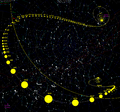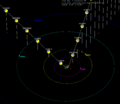ʻOumuamua facts for kids
ʻOumuamua (pronounced "oh-MOO-ah-MOO-ah") is a very special space object. Its name comes from the Hawaiian language and means "first messenger arriving from afar." It's special because it's the first object we've ever seen that came from outside our own solar system. Think of it as a visitor from another star system! Its official scientific name is 1I/2017 U1.
Scientists first spotted ʻOumuamua on October 19, 2017. They used the Pan-STARRS1 telescope at the Haleakala Observatory in Hawaii to find it.
ʻOumuamua looks long and narrow, like a cigar or a pancake. It has a dark red color, similar to other objects found far away in our solar system.
Contents
What is 'Oumuamua?
ʻOumuamua is known as an interstellar object. This means it traveled from a star system far away, beyond our Sun and its planets. It's different from comets or asteroids that usually stay within our solar system. Scientists believe it traveled through space for millions of years before reaching us.
Its Amazing Journey
ʻOumuamua entered our solar system from a direction near the Lyra constellation. It sped past the Sun and then continued its journey back out into deep space. Because it was moving so fast, the Sun's gravity couldn't pull it into an orbit around our star. Instead, it followed a path called a hyperbolic trajectory, which means it just curved around the Sun once and kept going.
Scientists were very excited to study ʻOumuamua because it gives us a chance to learn about other star systems. It's like getting a tiny sample from another part of our galaxy!
How We Found It
The Pan-STARRS1 telescope that discovered ʻOumuamua is designed to look for moving objects in the sky. When ʻOumuamua was first seen, it was already very close to Earth and moving quickly. This made it hard to study for a long time. Scientists had to act fast to gather as much information as they could before it moved too far away.
What Does It Look Like?
From the way its brightness changed as it tumbled through space, scientists figured out that ʻOumuamua is much longer than it is wide. It's estimated to be about 10 times longer than its width. Its dark red color might come from being exposed to cosmic radiation for a very long time. This radiation can change the surface of space rocks, making them darker and redder.
Scientists also noticed that ʻOumuamua didn't have a "tail" like most comets do. Comets usually release gas and dust when they get close to the Sun, forming a bright tail. The lack of a tail suggests ʻOumuamua is more like an asteroid, made of rock or metal, rather than ice.
Images for kids
-
Hyperbolic trajectory of ʻOumuamua through the inner Solar System with the Sun at the focus (animation)
See also
 In Spanish: 1I/ʻOumuamua para niños
In Spanish: 1I/ʻOumuamua para niños






